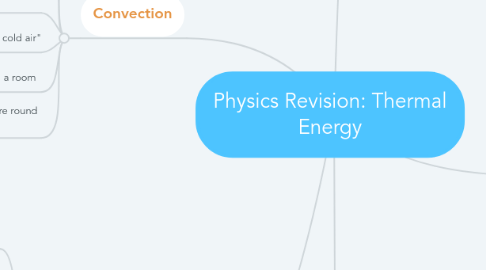
1. Convection
1.1. Works through Fluids
1.2. When heated, fluids move more
1.3. A fluid in a hot area is less dense than in cold areas so the hot fluid goes to the cold area.
1.4. "A current of hot and cold air"
1.4.1. Hot fluids go to cold areas as they are less dense particles
1.4.1.1. Hot fluid heats up cold areas
1.4.1.1.1. Colder fluids start to warm and transfer to hotter areas
1.5. Convection example: Radiator in a room
1.6. Convection test example: "Square round tube experiment"
2. Radiation
2.1. All objects emit and absorb radiation
2.2. Works in a vacuum, eg: space
2.3. Radiation is a transverse wave
2.4. Infrared radiation is any radiation carrying thermal energy
2.5. Thermal radiation is given off by anything with a higher temperature
2.6. As temperature increases, frequency increases, and wavelength decreases
2.7. Different surfaces emit and absorb radiation in different amounts
2.8. If an object is at a higher temperature than its surroundings it will emit more radiation than it absorbs
2.9. A matte, dark surface is best for radiation
2.10. A shiny, light surface is bad for radiation
2.11. Example of Radiation: The Sun
2.12. Example of radiation effects: Global Warming
2.13. Example
3. Definitions
3.1. Temperature
3.1.1. Crudely how hot something is
3.1.2. Similar to average thermal energy in particles
3.2. Thermal Energy
3.2.1. The measure of how much inernal energy in a material
3.2.2. How much energy it has gained through heating
3.3. Heat
3.3.1. Heating is the transfer of energy
3.4. Fluid
3.4.1. Liquids and Gases
3.5. Density = Mass/Volume
4. Conduction
4.1. Heat transfer between particles
4.2. Best through solids
4.3. Particles that vibrate more collide more transferring thermal energy between them
4.4. Metals are the best conductors
4.5. Non good conductors are called 'insulators'
4.6. Spreads through material
4.7. Conduction example: Metal pan
4.8. Conduction test example: "Conduction crown experiment"
5. Heat transfers throughout the house
5.1. Roof
5.1.1. Radiation
5.1.1.1. Aluminium foil/sheets are bad radiators
5.1.2. Convection
5.1.2.1. Fibre Insulation creates more particles to conduct through
5.2. Walls
5.2.1. Radiation
5.2.1.1. Foam insulation creates a bad radiating environment
5.2.2. Convection
5.2.2.1. Foam insulation stops convection pockets
5.3. Door
5.3.1. Radiation
5.3.1.1. Door Wedge stops heat from radiating under the door
5.4. Floor
5.4.1. Radiation
5.4.2. Conduction
5.4.2.1. Thicker floors
5.5. Windows
5.5.1. Radiation
5.5.2. Conduction
5.5.2.1. Double glazing can create a non conductible vacuum between glass panes

